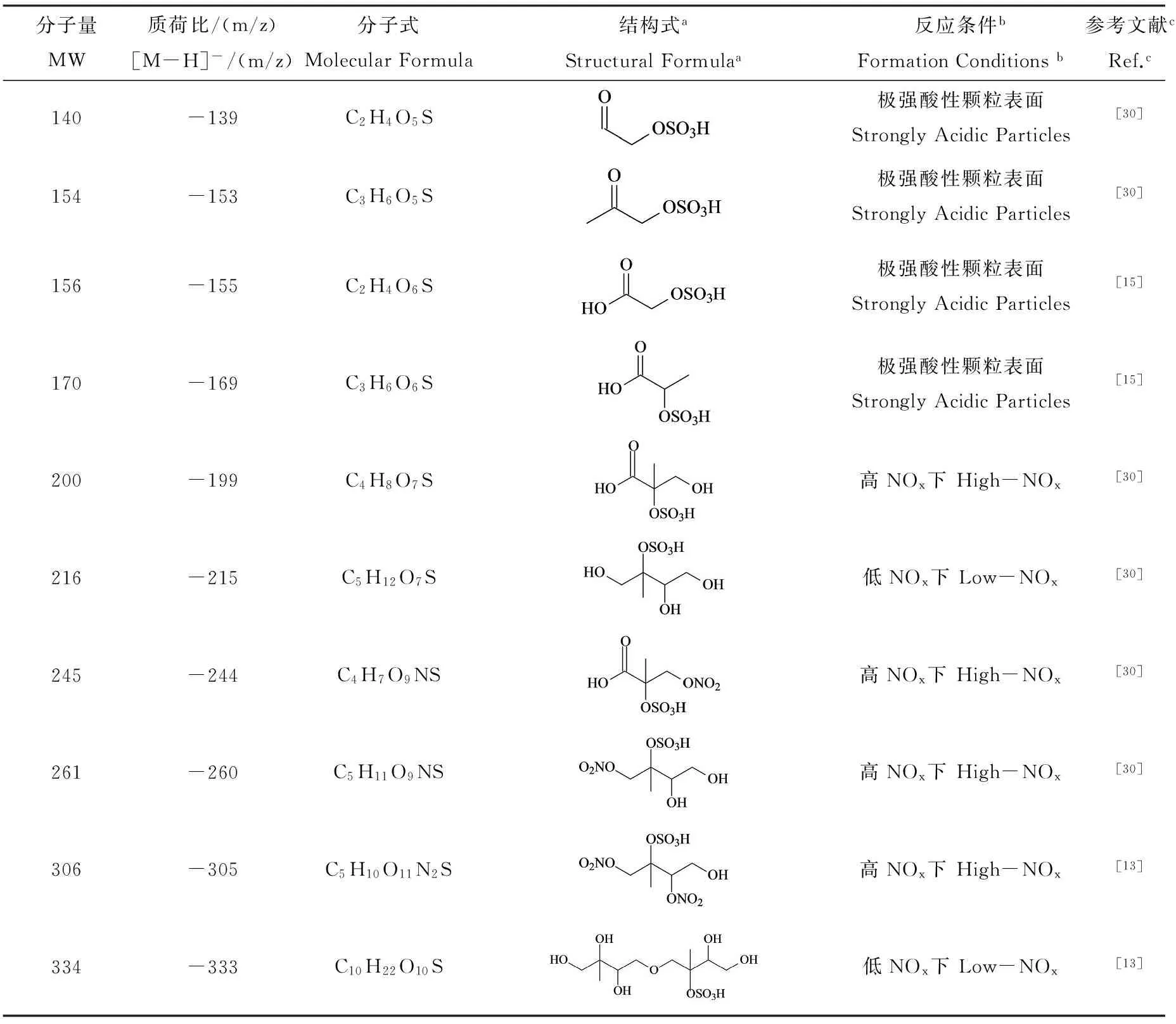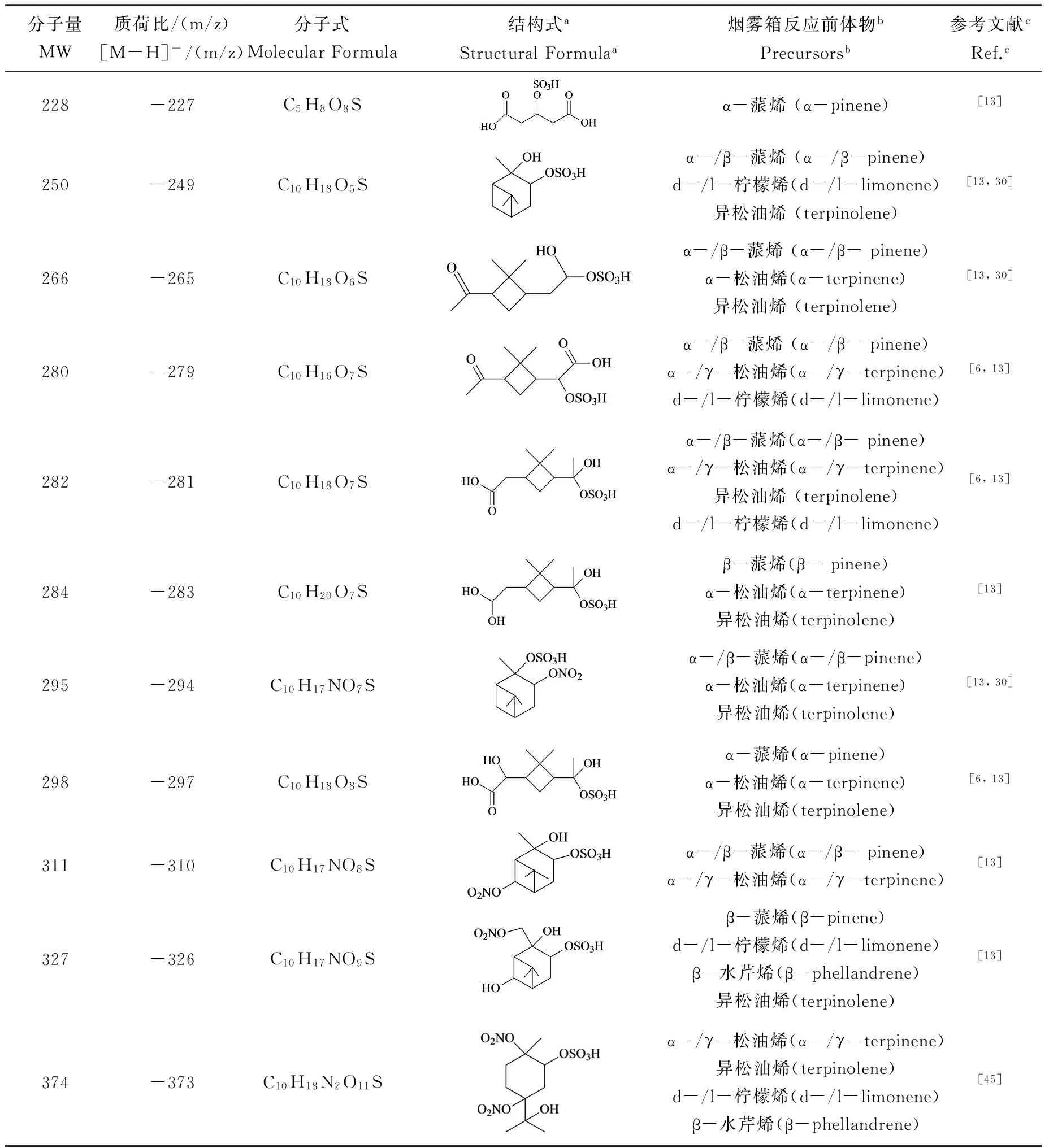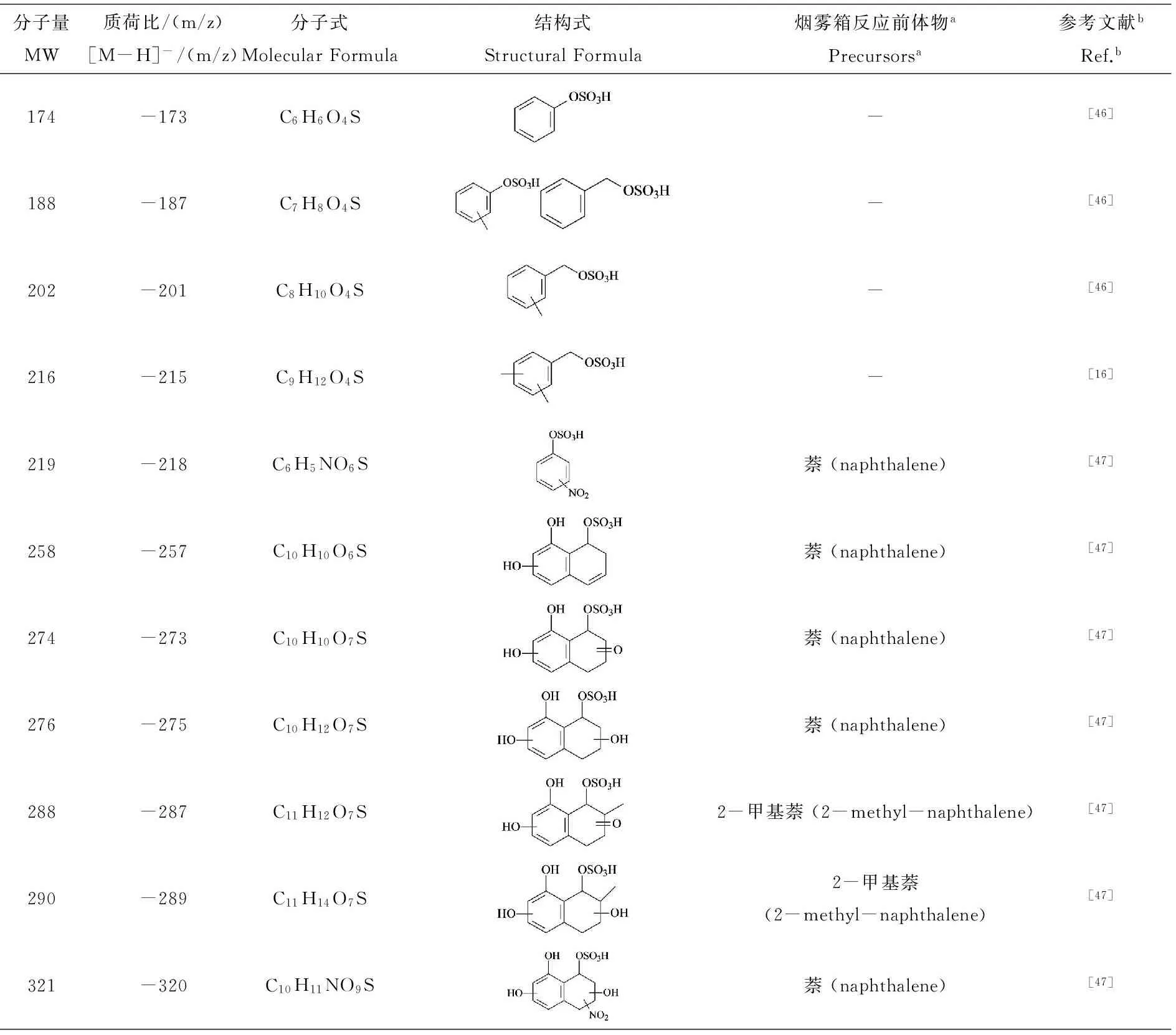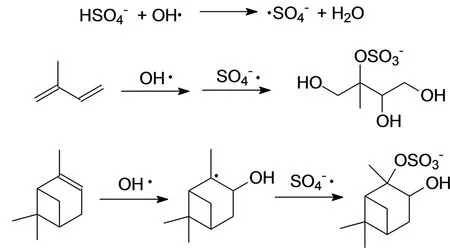大气硫酸酯研究进展
周易,李黎,2,,刘子芳,邓仕槐
1. 四川农业大学农村环境保护工程中心 四川农业大学环境学院,成都 611130 2. 清华大学 环境学院,北京 100084 3. 雅安市环境监测站,雅安 625014
大气硫酸酯研究进展
周易1,李黎1,2,,刘子芳3,邓仕槐1
1. 四川农业大学农村环境保护工程中心 四川农业大学环境学院,成都 611130 2. 清华大学 环境学院,北京 100084 3. 雅安市环境监测站,雅安 625014
硫酸酯是一类含有-OSO3H基团的有机化合物。它在大气中普遍存在。异戊二烯、单萜、倍半萜、芳烃、醛等均可通过大气自由基反应或非均相反应生成硫酸酯。本文在充分研读已有文献的基础上,总结探讨硫酸酯的分子结构、形成机制、分析方法以及硫酸酯对气溶胶有机物的贡献。最后,对未来研究的热点方向加以展望。
硫酸酯;形成机制;大气;异戊二烯;单萜;芳烃
Received 24 November 2015 accepted 18 March 2016
众所周知,硫是煤、石油、汽油、柴油等燃料中含量最高的杂质元素。在中国大多数地区,硫酸盐通常占气溶胶颗粒物总量近20~50%[1-4]。随着气溶胶成分研究进一步的深入,人们发现,主要来自于人为污染的气溶胶中的硫不仅以无机硫酸盐的形式存在,同样也可以以与有机物相结合的硫酸酯的形式存在。
硫酸酯(organosulfate)是指含有-OSO3H基团的有机化合物及其衍生物。它的化学结构差异很大,包括从小分子的硫酸酯单体到聚合而成的大分子腐殖质类有机物(humic-like substances,HULIS)[5]。对硫酸酯进行的定性测量已经表明,硫酸酯主要由脂肪族结构组成;除硫酸酯基团外,分子链上通常连接羟基、硝基和羧酸基团。
硫酸酯具有水溶和脂溶两性,它在颗粒物表面缔结成膜,可明显地改变大气颗粒物表面吸湿性[6],使得颗粒物具有形成云凝结核(cloud condensation nuclei,CCN)的活性。气溶胶中含硫和含氮有机物还具有较强的吸收太阳光的能力[7]。作为重要的一类二次有机气溶胶(SOA),有机物和硫酸或硫酸盐在气溶胶体系中反应生成硫酸酯可较好地解释酸催化下SOA数量明显增加的现象,并诠释了大气模型中颗粒相有机碳估算偏低的原因[8-9]。

马烨等[29]曾对大气硫酸酯2012年以前的研究成果进行了较为全面的总结。本文在充分研读文献的基础上,着眼于最新的研究成果,就当前国内外大气硫酸酯领域的研究进展再作一次系统的分析和阐述。
1 已发现的硫酸酯的化学结构与来源 (Molecular identification and sources of organosulfates)
Surratt等[30]和Gómez-Gonzalez等[12]几乎同时报道硫酸酯和硝基硫酸酯是异戊二烯烟雾箱反应生成SOA重要组成部分。Liggio等[31]发现蒎酮醛(pinonic acid)能迅速被酸性硫酸盐气溶胶吸收,生成蒎酮醛硫酸酯(m/z 265),蒎酮醛硫酸酯具有比蒎酮醛更高的蒸汽压,它是颗粒相中SOA组分之一。
目前,研究报道的气溶胶形成硫酸酯的前体物包括异戊二烯、单萜(主要是α-蒎烯、β-蒎烯和柠檬烯)、倍半萜、芳烃、醛等,以下对不同硫酸酯的化学结构做详细阐述。
1.1 以异戊二烯为前体物形成的硫酸酯
在北美和欧亚等地的气溶胶样本中,研究者发现了来自异戊二烯氧化生成的硫酸酯[12-13,15,20,30,32-35]。这些硫酸酯的前体物包括多元醇(如2-甲基丁四醇等)[12,30]、醛(如乙二醛,甲基乙二醛等)[12]、羟基羧酸(如2-甲基甘油酸、3-羟基戊二酸等)[12,15]。
由OH·引发的异戊二烯光氧化反应在不同NOx浓度下,在酸性和中性硫酸盐表面均能生成硫酸酯。在高浓度NOx下([NOx]>500 μg·L-1)可观察到硫酸酯和硝基硫酸酯的生成[13-14]。表1中列出的异戊二烯光氧化反应生成SOA中部分已经检测到的硫酸酯组分。硫酸酯m/z 215是2-甲基丁四醇的硫酸酯衍生物,可由异戊二烯光化学反应中间体—异戊二烯环氧二醇(isoprene epoxydiols,IEPOX)和硫酸盐的非均相反应生成[23],它的丰度随着硫酸种子酸度[36]和相对湿度[37]的上升而增加,m/z 215在低NOx以及富含气溶胶液相的条件下,占异戊二烯氧化产物中硫酸酯总量的多数[38]。m/z 215已经在大量野外实验中被发现[12-14, 18-20, 32-35, 39]。
异戊二烯、单萜和苯系物的光氧化均可反应生成乙二醛和甲基乙二醛。乙二醛和甲基乙二醛分别是形成硫酸酯m/z 155和m/z 169的前体物[12]。这类硫酸酯已经在环境气溶胶中[12, 13, 15, 30]以及雨水样品中被观测到[40]。在高NOx条件下异戊二烯光氧化反应可生成甲基丙烯基过氧硝酸酯(methacrylylperoxynitrate,MPAN)。MPAN进一步反应生成甲基丙烯酸环氧化物(methacrylic acid epoxide,MAE)和羟甲基-甲基-α-内酯(hydroxymethyl-methyl-α-lactone,HMML),MAE和HMML在气溶胶硫酸盐上的反应生成m/z 199[41-42]。m/z 199已经在美国东南部[13, 30]和匈牙利K-pusta[12]的环境气溶胶中被检测到。此外,烟雾箱实验还显示,在MACR的光氧化反应中,硫酸酯m/z 199在潮湿环境(相对湿度大于30%)比在干燥环境(相对湿度小于20%)下得到的产物更多[43]。
硫酸酯m/z 333是硫酸酯m/z 215和2-甲基丁四醇的缩水二聚物。在高NOx下异戊二烯光氧化反应还可以生成的一硝基硫酸酯和二硝基硫酸酯,分别为m/z 260 (C5H10O9NS-)和m/z 305 (C5H9O11N2S-),这些组分都出现在美国东南部气溶胶样本中[13]。
1.2 以单萜为前体物形成的硫酸酯
烟雾箱实验表明在不同NOx浓度下,在酸性硫酸盐表面,α-蒎烯均能生成硫酸酯[13]。但β-蒎烯、松油烯(terpinene)、异松油烯(terpinolene)、柠檬烯等则需要在高NOx下,酸性颗粒表面才可反应生成硫酸酯[13-14, 44]。表2中列出了单萜烟雾箱光氧化反应产物中已经检测到的硫酸酯组分。由α-/β-蒎烯、α-松油烯、异松油烯反应生成的硫酸酯m/z 265不仅在烟雾箱实验中检测到,而且在美国东南部大气气溶胶[13]、匈牙利K-puszta[12]、德国巴伐利亚[14]环境气溶胶中得到确认。
m/z 281被认为有可能是α-/β-蒎烯光氧化中间体蒎酮酸的酮基加成硫酸酯衍生物[6]。m/z 283可能是单萜的三羟基硫酸酯衍生物[6]。m/z 281和m/z 283在美国东南部气溶胶中一起被发现[13],在雨水样品中同样检测到m/z 281和m/z 283[40]。Nozière等[6]在外加UV光、双氧水和过硫酸盐的条件下,在实验室中将α-蒎烯加入到硫酸水溶液反应得到m/z 281和m/z 283。
m/z249为单萜的羟基硫酸酯衍生物[12-13],m/z 294为单萜的硝基硫酸酯衍生物[12-13]。在高NOx和强酸性条件下,单萜还可反应生成含有1个或2个硝酸基团的羟基硫酸酯(C10H16NO8S-,m/z 310;C10H17N2O11S-,m/z 373)[13]。此外,m/z 227被认为是α-蒎烯光氧化产物3-羟基戊二酸的硫酸酯衍生物[12, 13]。上述硫酸酯在森林地区大气气溶胶中均被发现[13-14, 20, 44]。

表1 常见的以异戊二烯为前体物形成的硫酸酯
注:a, 仅表示出一种同分异构体;b, 参照文献[30];c, 根据栏下参考文献画出结构式。Note:a, Only one isomer is presented;b, According to the Ref. [30];c, Structural formula were derived based on references listed in the right-side column.
1.3 芳香族硫酸酯(aromatic sulfate)
表3列出的是SOA中已经检测到的部分含有苯环的硫酸酯。m/z 173是酚硫酸酯(phenyl sulfate),m/z 187是甲酚硫酸酯(methylphenyl sulfate)或苄基硫酸酯(benyl sulfate)。m/z 201为甲苄基硫酸酯(methylbenyl sulfate)。m/z 215为三甲酚硫酸酯(trimethylphenyl sulfate)。Staudt等[46]在实验室中通过化学方法合成了酚硫酸酯、甲酚硫酸酯(包括3-和4-甲酚硫酸酯)、苄基硫酸酯和甲苄基硫酸酯(包括2-、3-和4-甲苄基硫酸酯),并采用合成的标准物质对环境气溶胶中硫酸酯进行了定量分析。Staudt等[46]的研究结果还显示,采用甲苯/NOx/酸性或中性(NH4)2SO4颗粒物进行类似于天然源VOCs的烟雾箱反应中,生成的SOA不含有苯系物硫酸酯。这说明气溶胶中上述苯系物硫酸酯的前体物不是通常认为的苯、甲苯或二甲苯,而有可能来自于其他来源(如含甲酚、木质素的生物质燃烧产物)。

表2 常见的以单萜为前体物形成的硫酸酯
注:a, 仅表示出一种同分异构体;b, 参照文献[13];c, 根据栏下参考文献画出结构式。Note:a, Only one isomer is presented;b, According to the Ref. [13];c, Structural formula were derived based on references listed in the right-side column.
萘和2-甲基萘是气相中丰度最高的2种多环芳烃。Riva等[47]通过烟雾箱实验证实萘和2-甲基萘在通入NO和紫外光照射下,于酸性或中性硫酸铵颗粒上可反应生成一系列的磺酸酯(sulfonate)和硫酸酯(如表3中所列出的m/z 218、257、273、275、287、289、320)。这些稠环结构的硫酸酯已经在巴基斯坦的拉舍尔和美国加州的帕萨迪娜大气细颗粒(PM2.5)中得到确认。以多环芳烃为前体物的硫酸酯是城市气溶胶中硫酸酯的重要组成成分。
1.4 其他硫酸酯
Zhang等[48]报道2-甲基-3-丁烯-2-醇(2-methyl-3-buten-2-ol,MBO)可通过大气光氧化生成环氧化物(MBO epoxide),环氧化物在酸性气溶胶表面生成MBO硫酸酯。该硫酸酯在美国科罗拉多州的落基山脉的森林气溶胶中被检测发现。Chan等[49]报道β-石竹烯(β-caryophyllene)在高NOx下酸性硫酸盐气溶胶烟雾箱实验中生成硫酸酯。Tao等[50]采用乙腈-甲苯的混合溶剂提取大气颗粒物样本,并在高效液相色谱/纳米解吸电喷雾离子源/高精度质谱仪(high performance liquid chromatography / nanospray desorption electrospray ionization / high resolution mass spectrometry, HPLC/Nano-DESI/ HRMS)上分析气溶胶中硫酸酯组成。他们发现在上海的强酸性城市气溶胶中有很多长链烷基硫酸酯,其前体物可能来自于汽车尾气。Tao等[50]推测这些饱和度较高的长链烷基硫酸酯是由带有脂肪长链的醇或醛与硫酸反应生成。参照Minerath等[51]的计算方法,当颗粒物的实时酸度为1.5、0和-2时,醇和硫酸经酯化反应生成硫酸酯的完全反应时间分别为4 600 d[51]、7 d[51]和0.23 h[18]。当颗粒相呈极强酸性(pH=2)时,颗粒物相中醇的硫酸的酯化反应可生成硫酸酯。但在一般的颗粒物酸性条件下(pH=1.5~4),由于反应速度太慢,醇和硫酸的酯化反应应不是气溶胶硫酸酯的主要生成途径。

表3 已发现的芳香族硫酸酯
注:a, 参照文献[47];b, 根据栏下参考文献画出结构式。
Note:a, According to the Ref. [47];b, Structural formula were derived based on references listed in the right-side column.
2 外场监测大气硫酸酯 (Field monitoring of atmospheric organosulfates)
He等[18]采集广州2007年夏秋两季大气细粒子样本,并分析了其中以异戊二烯和单萜为前体物形成的硫酸酯。研究发现α-蒎烯硫酸酯m/z 295是浓度最高的组分(夏季和秋季的平均浓度分别为52.4和151 ng·m-3)。它可能来源于α-蒎烯的大气光氧化反应和生物质燃烧。以异戊二烯为前体物的硫酸酯m/z 215的浓度较低(夏季和秋季的平均浓度分别为0.68和0.38 ng·m-3)。可能是由于采样期间较高的NOx浓度抑制了氧化中间体IEPOX的生成所致。
Ma等[17]在上海城区的气溶胶样本中检测到了异戊二烯、α-蒎烯、苯系物反应生成的硫酸酯。以异戊二烯为前体物生成的硫酸酯中,m/z 215浓度最高;以α-蒎烯为前体物的硫酸酯中,含量较高的是m/z 223、249和279。异戊二烯、α-蒎烯反应生成的硫酸酯为夏季硫酸酯的主要组成成分,春、夏、秋、冬四季的总的平均浓度分别为0.2、25.9、0.8和0.4 ng·m-3。苄基硫酸酯m/z 187四季变化趋势不明显,是冬季气溶胶中硫酸酯的主要组成成分。
外场研究还显示巴基斯坦拉合尔的环境气溶胶中苄基硫酸酯m/z 187在夏季和冬季PM2.5中的平均浓度为0.05和0.50 ng·m-3[16]。此外,Lin等[52]研究了东亚不同7个采样点(包括一个位于台湾的高山背景采样点和位于珠江三角洲和台湾的乡村、郊区和城市的各3个站点)细粒子HULIS中硫酸酯的组成。研究发现背景采样点HULIS中硫酸酯含量很低,而其他采样点样本中C9~C10硫酸酯和硝基硫酸酯在HULIS中的含量最高,显示单萜是这一区域硫酸酯形成的重要前体物。
和单体硫酸酯的含量相比,采用官能团总量或元素总量测定的硫酸酯总量占颗粒物有机物的比例要高得多。Surratt等[13]在美国东南部使用了X射线荧光光谱仪(X-ray fluorescence analyses,XRF)和离子色谱分别测定大气颗粒物中的总硫和无机硫,两者相减得到硫酸酯中硫的总量,认为硫酸酯中有机硫对气溶胶总硫的贡献约为20%,硫酸酯对颗粒有机物贡献率达到30%。采用类似的方法,Lukács等[53]监测发现匈牙利K-pusta森林地区PM2.5中硫酸酯中硫对气溶胶总硫的贡献率为6%~12%,硫酸酯对气溶胶有机物的贡献率也约为30%[13]。Tolocka和Turpin[54]监测了美国12个站点,得出硫酸酯对细颗粒(PM2.5)有机物的贡献值为5%~10%。此外,Hawkins等[21]使用傅里叶变换红外光谱(fourier transform infrared spectrometry,FTIR)测得太平洋东南部海洋气溶胶中硫酸酯占总有机物的(4±8)%。Frossard等[22]则报道欧洲和近大西洋附近北极区域气溶胶中约9%~11%的有机物和6%的硫的存在形式为硫酸酯。采用总量测定方法测定硫酸酯在大气总量丰度范围约占细颗粒物中有机物质量的4%~30%[13, 21-22, 53-54]。
3 大气硫酸酯的形成机制(Formation mechanisms of atmospheric organosulfates)
3.1 环氧化物与硫酸及硫酸盐气溶胶的反应
异戊二烯在低NOx浓度下的光氧化产物—IEPOX是气溶胶中硫酸酯的重要前体物[23, 32, 55]。IEPOX在酸性及中性硫酸盐颗粒上生成硫酸酯的反应机制见图1。在低NOx浓度下IEPOX产率更高。IEPOX在酸性硫酸盐气溶胶中反应生成硫酸酯的量显著多于它在中性颗粒物表面生成硫酸酯的量[14, 33]。

图1 Surratt等提出的低NOx下异戊二烯通过IEPOX中间体形成硫酸酯的反应机制[13]Fig. 1 Organosulfate formation mechanism in low-NOx atmosphere via IEPOX intermediates as proposed by Surratt et al. [13]
此外,Iinuma等[56]在实验室中合成了α-蒎烯环氧化物和β-蒎烯环氧化物,并将它们分别导入到烟雾箱中与硫酸盐颗粒发生反应,结果显示在酸性颗粒物表面α-蒎烯环氧化物和β-蒎烯环氧化物均反应生成硫酸酯m/z 294。α-蒎烯环氧化物在颗粒物表面还发生了分子重排,生成五元环结构的龙脑烯醛(campholenic aldehyde)。大气中含有不饱和双键的VOCs经大气光氧化生成环氧化物,环氧化物与硫酸及硫酸盐气溶胶的反应是低NOx下硫酸酯生成的重要反应途径。
3.2 羰基化合物在颗粒物表面的反应性摄取
羰基化合物在硫酸气溶胶上的非均相反应是硫酸酯的另一种重要来源。Liggio等[24]最早报道乙二醛在硫酸盐颗粒物表面发生非均相反应,生成明显数量的低聚物和硫酸酯。通过进一步的研究,Galloway等[57]发现乙二醛羰基加成生成的半缩醛硫酸酯(见下图2中化合物1)不稳定,硫酸酯基团在水提取过程中易水解生成醇和在甲醇提取过程中发生甲酯化取代。并且,乙二醛只有在有光照的条件下,才能在硫酸盐表面反应生成硫酸酯m/z 155。Olson等[15]通过在实验室里合成标准物进行对比,确认乙二醛和甲基乙二醛反应生成稳定的硫酸酯不是乙二醛硫酸酯(1)和甲基乙二醛硫酸酯(2),确切的结构是乙醇酸硫酸酯(glycolic acid sulfate,3)和乳酸硫酸酯(lactic acid sulfate,4)(见下图2)。

图2 乙二醛和甲基乙二醛反应生成硫酸酯可能的反应机制[15, 57]Fig. 2 A possible formation mechanism of organosulfates from glyoxal and methylglyoxal [15, 57]



图3 Nozière et al. 提出的异戊二烯和α-蒎烯与OH·和·反应生成硫酸酯的形成机制[6]Fig. 3 Organosulfates formation mechanisms from photoxidation of isoprene and α-pinene via OH· and · initiated oxidation as proposed by Nozière et al. [6]
3.4 夜间NO3·化学对硫酸酯生成的贡献
和硫酸酯相比较,硝酸酯更容易发生水解反应生成硝酸和相应的醇,或与硫酸盐发生亲核取代反应转化成相应的硫酸酯和硝酸[28],见以下反应(1)和(2)。
RONO2+H2O→ROH+HNO3
(1)
RONO2+H2SO4→ROSO3H+HNO3
(2)
研究结果表明,在大气气溶胶中,醇比相应的硫酸酯和硝酸酯自由能更低,结构更为稳定。环境大气中之所以存在硫酸酯和硝酸酯的原因可能是体系存在能垒,如水分短缺或硫酸盐和硝酸盐含量非常高。不同碳原子上加成的硫酸酯和硝酸酯发生水解反应的困难程度分别为伯碳加成物>仲碳加成物>叔碳加成物。叔碳上加成的硫酸酯和硝酸酯在大气中含量被认为超过了相应的伯碳和仲碳加成物[28]。硝酸根亲核加成在叔碳生成的硝酸酯(tertiary organonitrate)在常规的环境条件下可迅速发生亲核取代反应,生成醇类或硫酸酯化合物,说明叔碳硝酸酯在环境中无法稳定存在。这就是我们为什么在大气颗粒物中监测到的硫酸酯化合物比硝酸酯化合物多的原因[27-28]。
硝酸酯的形成途径可以是NO3·自由基进攻BVOCs的不饱和双键,这一反应途径主要在夜间发生;也可以是大气烷基过氧自由基(RO2·)和NO之间的反应,后者主要在白天进行。外场研究表明夜晚气溶胶中硝酸酯含量要明显高于白天,显示夜间NO3·反应途径对硝酸酯形成的重要性。硝酸酯在颗粒物表面与硫酸发生亲核取代反应生成硫酸酯也被认为是很多研究发现硫酸酯在夜间气溶胶中含量高的原因。
4 硫酸酯的分析检测方法(The analytical methods of organosulfates)
Romero等[10]最先报道采用高效液相色谱(high performance liquid chromatography,HPLC)和电喷雾离子源质谱(electrospray ionization mass spectrometry,ESI-MS)联用技术检测外场大气中的硫酸酯。目前,HPLC/ESI-MS联用技术被广泛应用于硫酸酯的分析检测。该分析过程通常是首先提取膜样品;应用固相萃取(solid phase extraction,SPE)小柱去除提取液中水溶性离子(主要是硫酸盐)的干扰;或是直接过滤,将滤液吹干并转换溶剂;最终注入HPLC/ESI/MS进行分析。通常采用多级质谱联用对化合物进行结构鉴定。提取分子离子的峰面积进行定量。
Reemtsma等[11]则最先报道采用高效液相色谱-傅里叶变换离子回旋共振质谱(high performance liquid chromatography / fourier-transform ion cyclotron resonance mass spectrometry, HPLC/FT-ICRMS)检测大气硫酸酯。FT-ICRMS可以获取化合物分子中C、H、O、N、S元素的含量,对硫酸酯进行定性和定量分析。
在线的质谱测量方法可提供气溶胶组成的实时信息。Hatch等[33]利用气溶胶飞行时间质谱(aerosol time-of-flight mass spectrometry,ATOFMS)检测美国亚特兰大大气中异戊二烯生成的硫酸酯,他们发现m/z 215是含量最高的硫酸酯组分,它的浓度呈现夜高昼低的趋势,且浓度峰值通常紧跟在O3峰值的后面。推测异戊二烯的光氧化反应对O3的形成有重要的贡献,氧化中间体IEPOX有可能在夜间沉降到颗粒表面和硫酸盐反应生成m/z 215,或者夜间与NO3·反应生成硝酸酯进一步转化为硫酸酯。
Wang等[58]利用离子对液相色谱成功分离了以异戊二烯为前体物的硫酸酯m/z 215中erythro-和threo-两种同分异构体,并证实erythro-异构体的含量高于threo-异构体,且m/z 215分子中硫酸酯基团接于分子中C2或C3位上。
大气中硫酸酯种类繁多,由于缺乏真正的标准物,研究人员通常采用替代标准物(surrogate)对烟雾箱实验和大气气溶胶中的不同种类硫酸酯进行定量分析。丁四醇硫酸酯(2,3-epoxy-1,4-butanediols sulfate, BEPOX sulfate)[13]和丙基硫酸钠(sodium propylsulfate)[59]被报道用作替代标准物定量异戊二烯氧化生成的硫酸酯。樟脑磺酸(camphor-10-sulfonic acid)[18, 20, 44],半乳糖硫酸钠(sodium galactose sulfate)[35],2-乙基己基硫酸钠(sodium 2-ethylhexyl sulfate)[5],辛基硫酸钠(sodium octyl sulfate)[10, 17]和癸基硫酸钠(sodium decyl sulfate)[60]则被报道用做替代标准物定量单萜氧化生成的硫酸酯。在少数的一些研究中,合成的标准物被用于待测物的分析。如Olson等[15]应用合成的乳酸硫酸酯和乙醇酸硫酸酯分析环境气溶胶中硫酸酯m/z 155和m/z 169的含量;Staudt等[46]采用合成的酚硫酸酯、甲酚硫酸酯、苄基硫酸酯、甲苄基硫酸酯标准物分析拉舍尔气溶胶中苯系物硫酸酯m/z 173、187和201。替代标准物提供了有机硫酸酯浓度的一个近似值,它在质谱监测中的行为并不能完全代表被分析物在质谱检测中的行为特征。
5 未来的研究方向(Future research directions)
作为一类新型的气溶胶有机物,大气硫酸酯的研究方兴未艾。目前,研究者致力于它的结构、含量、形成机制、影响因素以及对环境、气候和健康的影响。合成标准物对从分子结构上定性定量硫酸酯无疑是一项重要的基础工作。在形成机制和影响因素的确定上,应更重在实验室研究和环境外场监测的并举,提出可应用于实际环境大气条件的反应机制和变化规律。尤其是夜间NO3·化学反应,由于研究较少,应引起特别关注。此外,由于硫酸酯可以单分子形式存在,也可以聚合生成腐殖质类的物质,对HULIS中硫酸酯的鉴定和分析也许是我们了解未知SOA结构的重要突破口。如文中所述,含硫和含氮有机物可明显地吸收太阳光且影响颗粒表面性质,因此,大气硫酸酯对气溶胶能见度,成云特性的影响也是一项具有重要实际意义的研究。
致谢:感谢审稿人在文章修改中给予的帮助。
[1] Li L, Wang W, Feng J, et al. Composition, source, mass closure of PM2.5aerosols for four forests in eastern China [J]. Journal of Environmental Sciences, 2010, 22(3): 405-412
[2] Yang F, Tan J, Zhao Q, et al. Characteristics of PM2.5speciation in representative megacities and across China [J]. Atmospheric Chemistry and Physics, 2011, 11(11): 5207-5219
[3] Feng J, Hu M, Chan C K, et al. A comparative study of the organic matter in PM2.5from three Chinese megacities in three different climatic zones [J]. Atmospheric Environment, 2006, 40(21): 3983-3994
[4] Mo H, Li L, Lai W,et al. Characterization of summer PM2.5aerosols from four forest areas in Sichuan, SW China [J]. Particuology, 2015, 20(3): 94-103
[5] Stone E A, Hedman C J, Sheesley R J, et al. Investigating the chemical nature of humic-like substances (HULIS) in North American atmospheric aerosols by liquid chromatography tandem mass spectrometry [J]. Atmospheric Environment, 2009, 43(27): 4205-4213
[6] Nozière B, Ekström S, Alsberg T, et al. Radical-initiated formation of organosulfates and surfactants in atmospheric aerosols [J]. Geophysical Research Letters, 2010, 37(L5): 137-147
[7] Nguyen T B, Lee P B, Updyke K M, et al. Formation of nitrogen- and sulfur-containing light-absorbing compounds accelerated by evaporation of water from secondary organic aerosols [J]. Journal of Geophysical Research, 2012, 117(D1): 815-817
[8] Iinuma Y, Kahnt A, Mutzel A, et al. Ozone-driven secondary organic aerosol production chain [J]. Environmental Science & Technology, 2013, 47(8): 3639-3647
[9] Pye H O, Pinder R W, Piletic I R, et al. Epoxide pathways improve model predictions of isoprene markers and reveal key role of acidity in aerosol formation [J]. Environmental Science & Technology, 2013, 47(19): 11056-11064
[10] Romero F, Oehme M. Organosulfates - A new component of humic-like substances in atmospheric aerosols? [J]. Journal of Atmospheric Chemistry, 2005, 52 (3): 283-294
[11] Reemtsma T, These A, Venkatachari P, et al. Identification of fulvic acids and sulfated and nitrated analogues in atmospheric aerosol by electrospray ionization fourier transform ion cyclotron resonance mass spectrometry [J]. Analytical Chemistry, 2006, 78(24): 8299-8304
[12] Gómez-Gonzalez Y, Surratt J D, Cuyckens F, et al. Characterization of organosulfates from the photooxidation of isoprene and unsaturated fatty acids in ambient aerosol using liquid chromatography/(-) electrospray ionization mass spectrometry [J]. Journal of Mass Spectrometry, 2008, 43(3): 371-382
[13] Surratt J D, Gómez-González Y, Chan A W H, et al. Organosulfate formation in biogenic secondary organic aerosol [J]. Journal of Physical Chemistry A, 2008, 112(36): 8345-8378
[14] Iinuma Y, Müller C, Berndt T, et al. Evidence for the existence of organosulfates from beta-pinene ozonolysis in ambient secondary organic aerosol [J]. Environmental Science & Technology, 2007, 41(19): 6678-6683
[15] Olson C N, Galloway M M, Yu G, et al. Hydroxycarboxylic acid-derived organosulfates: Synthesis, stability, and quantification in ambient aerosol [J]. Environmental Science & Technology, 2011, 45(15): 6468-6474
[16] Kundu S, Quraishi T A, Yu G, et al. Evidence and quantitation of aromatic organosulfates in ambient aerosols in Lahore, Pakistan [J]. Atmospheric Chemistry and Physics, 2013, 13(9): 4865-4875
[17] Ma Y, Xu X, Song W, et al. Seasonal and diurnal variations of particulate organosulfates in urban Shanghai, China [J]. Atmospheric Environment, 2014, 85(2): 152-160
[18] He Q F, Ding X, Wang X M, et al. Organosulfates from pinene and isoprene over the Pearl River Delta, South China: Seasonal variation and implication in formation mechanisms [J]. Environmental Science & Technology, 2014, 48(16): 9236-9245
[19] Gómez-González Y, Wang W, Vermeylen R, et al. Chemical characterisation of atmospheric aerosols during a 2007 summer field campaign at Brasschaat, Belgium: Sources and source processes of biogenic secondary organic aerosol [J]. Atmospheric Chemistry and Physics, 2012, 12(1): 125-138
[20] Kristensen K, Glasius M. Organosulfates and oxidation products from biogenic hydrocarbons in fine aerosols from a forest in North West Europe during spring [J]. Atmospheric Environment, 2011, 45(27): 4546-4556
[21] Hawkins L N, Russell L M, Covert D S, et al. Carboxylic acids, sulfates, and organosulfates in processed continental organic aerosol over the southeast Pacific Ocean during VOCALS-REx 2008 [J]. Journal of Geophysical Research, 2010, 115(D13): 411-454
[22] Frossard A A, Shaw P M, Russell L M, et al. Springtime Arctic haze contributions of submicron organic particles from European and Asian combustion sources [J]. Journal of Geophysical Research, 2011, 116(D5): 420-424
[23] Surratt J D, Chan A W, Eddingsaas N C, et al. Reactive intermediates revealed in secondary organic aerosol formation from isoprene [J]. Proceedings of the National Academy of Sciences, 2010, 107(15): 6640-6645
[24] Liggio J, Li S, Mclaren R. Heterogeneous reactions of glyoxal on particulate matter identification of acetals and sulfate esters [J]. Environmental Science & Technology, 2005, 39(6): 1532-1541
[25] Liggio J, Li S M. Organosulfate formation during the uptake of pinonaldehyde on acidic sulfate aerosols [J]. Geophysical Research Letters, 2006, 33(L13): 338-345
[26] Perri M J, Lim Y B, Seitzinger S P, et al. Organosulfates from glycolaldehyde in aqueous aerosols and clouds: Laboratory studies [J]. Atmospheric Environment, 2010, 44(21): 2658-2664
[27] Hu K S, Darer A I, Elrod M J. Thermodynamics and kinetics of the hydrolysis of atmospherically relevant organonitrates and organosulfates [J]. Atmospheric Chemistry and Physics, 2011, 11(16): 8307-8320
[28] Darer A I, Cole-Filipiak N C, O'connor A E, et al. Formation and stability of atmospherically relevant isoprene-derived organosulfates and organonitrates [J]. Environmental Science & Technology, 2011, 45(5): 1895-1902
[29] 马烨, 陈建民, 王琳. 大气有机硫酸酯化合物的特征及形成机制 [J]. 化学进展, 2012, 24(11): 2277-2286
Ma Y, Chen J M, Wang L.Characteristics and formation mechanisms of atmospheric organosulfates [J]. Progresses in Chemistry, 2012, 24(11): 2277-2286 (in Chinese)
[30] Surratt J D, Kroll J H, Kleindienst T E, et al. Evidence for organosulfates in secondary organic aerosol [J]. Environmental Science & Technology, 2007, 41(2): 517-527
[31] Liggio J, Li S M. Reactive uptake of pinonaldehyde on acidic aerosols [J]. Journal of Geophysical Research, 2006, 111(D24): 257-262
[32] Froyd K D. Murphy S M, Murphy D M, et al. Contribution of isoprene-derived organosulfates to free tropospheric aerosol mass [J]. Proceedings of the National Academy of Sciences, 2010, 107(50): 21360-21365
[33] Hatch L E, Creamean J M, Ault A P, et al. Measurements of isoprene-derived organosulfates in ambient aerosols by aerosol time-of-flight mass spectrometry - part 1: Single particle atmospheric observations in Atlanta [J]. Environmental Science & Technology, 2011, 45(12): 5105-5111
[34] Hatch L E, Creamean J M, Ault A P, et al. Measurements of isoprene-derived organosulfates in ambient aerosols by aerosol time-of-flight mass spectrometry-part 2: Temporal variability and formation mechanisms [J]. Environmental Science & Technology, 2011, 45(20): 8648-8655
[35] Stone E A, Yang L, Yu L E, et al. Characterization of organosulfates in atmospheric aerosols at four Asian locations [J]. Atmospheric Environment, 2012, 47(1): 323-329
[36] Surratt J D, Lewandowski M, Offenberg J H, et al. Effect of acidity on secondary organic aerosol formation from isoprene [J]. Environmental Science & Technology, 2007, 41(15): 5363-5369
[37] Zhang H, Surratt J D, Lin Y H, et al. Effect of relative humidity on SOA formation from isoprene/NO photooxidation: Enhancement of 2-methylglyceric acid and its corresponding oligoesters under dry conditions [J]. Atmospheric Chemistry and Physics, 2011, 11(13): 6411-6424
[38] Mcneill V F, Woo J L, Kim D D, et al. Aqueous-phase secondary organic aerosol and organosulfate formation in atmospheric aerosols: A modeling study [J]. Environmental Science & Technology, 2012, 46(15): 8075-8081
[39] Worton D R, Goldstein A H, Farmer D K, et al. Origins and composition of fine atmospheric carbonaceous aerosol in the Sierra Nevada Mountains, California [J]. Atmospheric Chemistry and Physics, 2011, 11(19): 10219-10241
[40] Altieri K E, Turpin B J, Seitzinger S P. Oligomers, organosulfates, and nitrooxy organosulfates in rainwater identified by ultra-high resolution electrospray ionization FT-ICR mass spectrometry [J]. Atmospheric Chemistry and Physics, 2009, 8(5): 2533-2542
[41] Lin Y H, Zhang H F, Pye H O T, et al. Epoxide as a precursor to secondary organic aerosol formation from isoprene photooxidation in the presence of nitrogen oxides [J]. Proceedings of the National Academy of Sciences, 2013, 110(17): 6718-6723
[42] Nguyen T B, Bates K H, Crounse J D, et al. Mechanism of the hydroxyl radical oxidation of methacryloyl peroxynitrate (MPAN) and its pathway toward secondary organic aerosol formation in the atmosphere [J]. Physical Chemisty Chemical Physics, 2015, 17(27): 17914-17926
[43] Zhang H, Lin Y H, Zhang Z,et al. Secondary organic aerosol formation from methacrolein photooxidation: Roles of NOx level, relative humidity and aerosol acidity [J]. Environmental Chemistry, 2012, 9(3): 247-263
[44] Iinuma Y, Müller C, Böge O,et al. The formation of organic sulfate esters in the limonene ozonolysis secondary organic aerosol (SOA) under acidic conditions [J]. Atmospheric Environment, 2007, 41(27): 5571-5583
[45] Surratt J D.Analysis of the chemical composition of atmospheric organic aerosols by mass spectrometry [D]. California: California Institute of Technology, 2010, 5: 241
[46] Staudt S, Kundu S, Lehmler H J, et al. Aromatic organosulfates in atmospheric aerosols: Synthesis, characterization, and abundance [J]. Atmospheric Environment, 2014, 94(7): 366-373
[47] Riva M, Tomaz S, Cui T, et al. Evidence for an unrecognized secondary anthropogenic source of organosulfates and sulfonates: Gas-phase oxidation of polycyclic aromatic hydrocarbons in the presence of sulfate aerosol [J]. Environmental Science & Technology, 2015, 49(11): 6654-6664
[48] Zhang H, Zhang Z, Cui T, et al. Secondary organic aerosol formation via 2-methyl-3-buten-2-ol photooxidation: Evidence of acid-catalyzed reactive uptake of epoxides [J]. Environmental Science Technology Letter, 2014, 1(4): 242-247
[49] Chan M N, Surratt J D, Chan A W H, et al. Influence of aerosol acidity on the chemical composition of secondary organic aerosol from beta-caryophyllene [J]. Atmospheric Chemistry and Physics, 2011, 11(4): 1735-1751
[50] Tao S, Lu X, Levac N, et al. Molecular characterization of organosulfates in organic aerosols from Shanghai and Los Angeles urban areas by nanospray-desorption electrospray ionization high-resolution mass spectrometry [J]. Environmental Science & Technology, 2014, 48(18): 10993-11001
[51] Minerath E C, Casale M T, Elrod M J. Kinetics feasibility study of alcohol sulfate esterification reactions in tropospheric aerosols [J]. Environmental Science & Technology, 2008, 42(12): 4410-4415
[52] Lin P, Yu J Z, Engling G, et al. Organosulfates in humic-like substance fraction isolated from aerosols at seven locations in East Asia: A study by ultra-high-resolution mass spectrometry [J]. Environmental Science & Technology, 2012, 46(24): 13118-13127
[53] Lukács H, Gelencsér A, Hoffer A, et al. Quantitative assessment of organosulfates in size-segregated rural fine aerosol [J]. Atmospheric Chemistry and Physics, 2009, 9(1): 231-238
[54] Tolocka M P, Turpin B. Contribution of organosulfur compounds to organic aerosol mass [J]. Environmental Science & Technology, 2012, 46(15): 7978-7983
[55] Paulot F, Crounse J D, Kjaergaard H G, et al. Unexpected epoxide formation in the gas-phase photooxidation of isoprene [J]. Science, 2009, 325(5941): 730-733
[56] Iinuma Y, Böge O, Kahnt A, et al. Laboratory chamber studies on the formation of organosulfates from reactive uptake of monoterpene oxides [J]. Physical Chemistry Chemical Physics, 2009, 11(36): 7985-7997
[57] Galloway M M, Chhabra P S, Chan A W H, et al. Glyoxal uptake on ammonium sulphate seed aerosol reaction products and reversibility of uptake under dark and irradiated conditions [J]. Atmospheric Chemistry and Physics, 2009, 9(10): 3331-3345
[58] Wang W, Shalamzari M S, Maenhaut W, et al. Ion-pairing liquid chromatography/negative ion mass spectrometry for improved analysis of polar isoprene-related organosulfates [J]. Rapid Communication in Mass Spectrometry, 2013, 27(13): 1585-1589
[59] Lin Y H, Knipping E M, Edgerton E S, et al. Investigating the influences of SO2and NH3levels on isoprene-derived secondary organic aerosol formation using conditional sampling approaches [J]. Atmospheric Chemistry and Physics, 2013, 13(16): 8457-8470
[60] Kahnt A, Behrouzi S, Vermeylen R, et al. One-year study of nitro-organic compounds and their relation to wood burning in PM10aerosol from a rural site in Belgium [J]. Atmospheric Environment, 2013, 81(2): 561-568
◆
Review of Atmospheric Organosulfate Studies
Zhou Yi1, Li Li1,2,*, Liu Zifang3, Deng Shihuai1
1. Rural Environment Protection Engineering & Technology Center of Sichuan Province, College of Environment, Sichuan Agricultural University, Chengdu 611130, China 2. School of Environment, Tsinghua University, Beijing 100084, China 3. Ya’an Environmental Monitoring Center, Ya’an 625014, China
Organosulfate is a widespread atmospheric organic matter type containing -OSO3H group. It can be formed from a variety of precursors including isoprene, monoterpenes, sesquiterpenes, aromatics and aldehydes, etc., via atmospheric radical reactions and heterogeneous reactions. This work summarizes the up-to-date knowledge on structures, formation mechanisms and analytical methods of organosulfates. The contributions of organosulfates to aerosol organic matters was discussed also. Future research needs on organosulfates were presented in the end of this article.
organosulfate; formation mechanism; atmosphere; isoprene; monoterpene; aromatics
10.7524/AJE.1673-5897.20151124002
国家自然基金(No. 41073101);四川省教育厅青年基金(No. 11ZB065);清华大学大气复合污染来源与控制实验室2015开放基金
周易(1992-),男,硕士研究生,研究方向为大气环境化学,E-mail: 1339280235@qq.com
*通讯作者(Corresponding author), E-mail: lili@sicau.edu.cn
2015-11-24 录用日期:2016-03-18
1673-5897(2016)2-069-11
X171.5
A
简介:李黎(1972—),女,博士,副教授,主要研究方向为大气环境化学,发表学术论文30余篇。
周易, 李黎, 刘子芳, 等. 大气硫酸酯研究进展[J]. 生态毒理学报,2016, 11(2): 69-79
Zhou Y, Li L, Liu Z F, et al. Review of atmospheric organosulfate studies [J]. Asian Journal of Ecotoxicology, 2016, 11(2): 69-79 (in Chinese)

